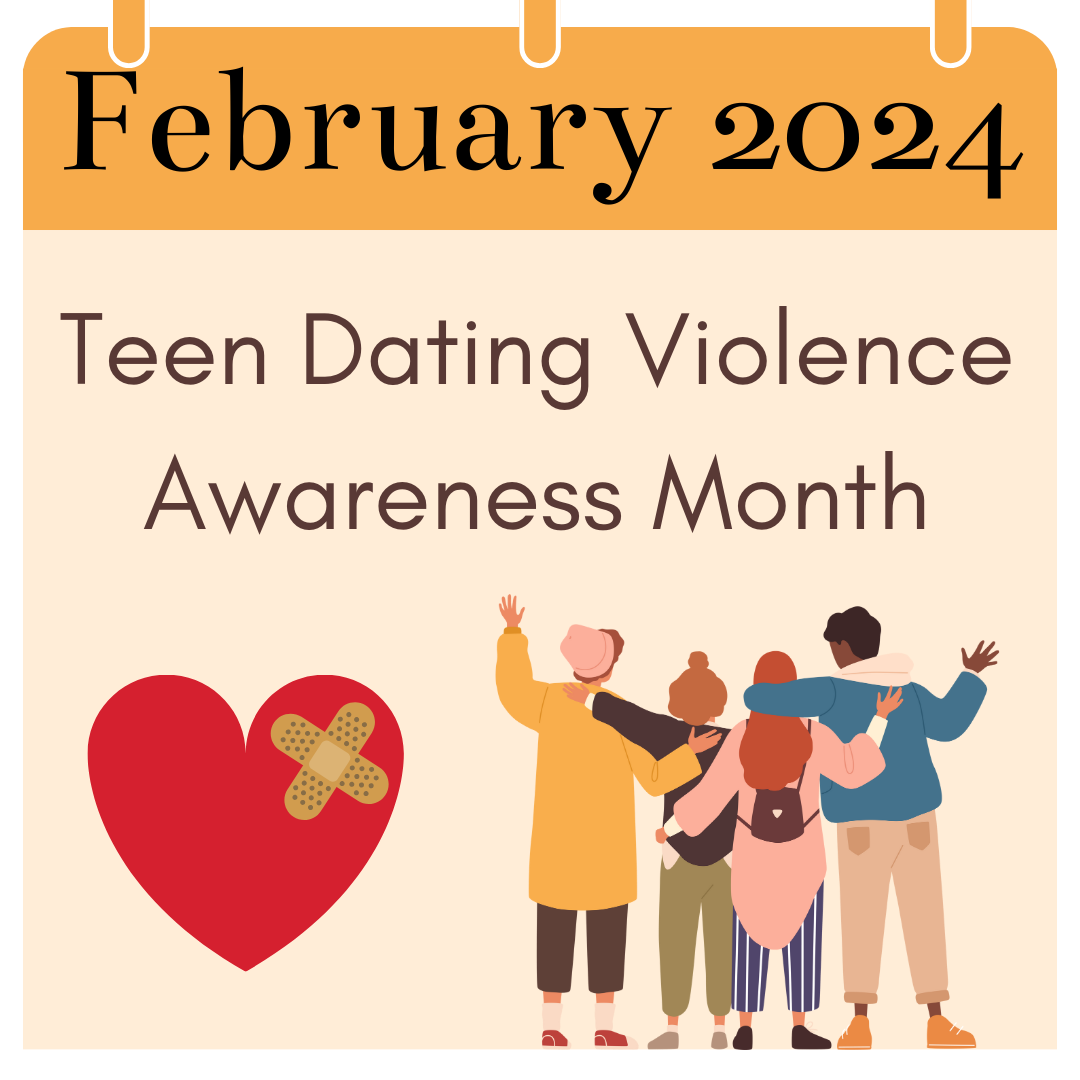- Kas Roush
- Feb, 16, 2024
- Blog
- One Comments
A Love Like That
Teen Dating Violence (TDV) is a form of intimate-partner violence. The victim is a teenager, with the abuser most likely to be a teen as well. The violence can include but is not limited to physical, sexual, emotional, psychological, or stalking.

What is "That"?
A Healthy Relationship can include:
- Mutual respect and interest
- Feeling open and safe to talk to your partner(s), particularly about difficult topics
- Being honest with your partner(s), without the fear of retaliation or harm
- Equal say in decisions, with compromise when necessary
- Establishing boundaries, respecting them and feeling respected
- Having relationships, friends and family, outside of your partner(s)
- Practicing consent
No two relationships look the same, not even within polyamorous couples. However, every healthy relationship is built from the foundation of honesty, communication, respect, equality, and consent.
An Unhealthy Relationship can include:
- Your partner(s) disrespects, distrusts, and disregards you
- Fear of retaliation or harm
- Your partner(s) always having the final say despite your wishes
- Your partner(s) humiliate you, particularly in public or online
- Your partner(s) do not communicate their feelings
- Your partner(s) prevent you from having social connections outside of them
Abusive relationships are born out of unhealthy ones. Some actions can include mistreatment, accusations of cheating when there is none, isolating partner(s) completely from social connections, and enacting violence onto their partner(s). There is not a fine line to determine when a relationship becomes abusive. Regardless, abusive actions should never be tolerated or seen as normal. Everyone deserves a relationship free from violence and fear.
If you or a loved one believes that they are in an abusive relationship, please reach out to our phone number 269-673-8700
You must also take time to check in with yourself. You have a relationship between your body and mind. To take care of one begets the care of another.
When was the last time you did something for yourself? Big or small. These actions of caring for yourself fosters love within yourself. A healthy body, mind, and attitude makes a healthy person.
Take some time today to practice self-care
- Wear your favorite clothes
- Take a spa day to treat yourself
- Drink your favorite tea, coffee, etc and think about why you like that flavor
- Journal what ever is on your mind
- Take a walk outside and breathe in a deep breath
Anything that makes you feel relaxed or energized! You deserve a love like that!
Teens are an emotionally vulnerable population due to their developing brains, growing societal responsibilities, and naturally curious ventures into "adult" practices. In the practice of osmosis, they model what they have learned from adults and their peers. This modeling can be a double-edged sword, as without the proper education to inform them of safe practices versus non-safe, teens can engage in mean, dangerous, and even abusive behavior
In this digital age, information is click of button away. Feeds overloading the sense. News filling the ear. Connections and interactions--unmonitored and unfiltered--occur between the whole world. It is now, more than ever, to help teenagers learn what is a healthy relationship vs an unhealthy one, how to establish boundaries, and how to navigate the difficult world of adult relationships.
Consent:
Consent is key to a healthy relationship. More often, people bring up "consent" in a relationship when talking about physical intimacy (kissing, sex, etc). However, consent is practiced everywhere. When you are asking to enter into another person's personal life, personal space, knowledge of their thoughts or feelings. When you ask "can I?", you are asking for consent to proceed.
Planned Parenthood made a handy little acronym to remember how to practice consent: FRIES
F: Freely Given
The person being asked must freely give consent. This should be done without pressure, manipulation, or under the influence of drugs or alcohol. The person should consider if they truly want to proceed. It is always a choice.
The person(s) asking should remember the importance of accepting a 'no'.
R: Reversible
Anyone can change their mind at any time. It does not matter if they said "yes" at first, have done it before, or were just 'getting to the good part'. The consent can be revoked. The person(s) asking should accept the change. Pressuring them into reconsidering or saying "but we already started" or "you already said yes" is makes the answer no longer freely given, thus making it NOT consent.
I: Informed
Consent needs information. In regards to sex, a partner not disclosing any STDs, birth control, or condom use is not informed. Being open and honest with one another creates the best way to make the best decision. Sharing information can be scary, but being informed is being safe!
E: Enthusiastic
No one wants to do something that they don't enjoy. Doing something out of obligation does not make it fun.
S: Specific
It should be clear what you're doing. There's nothing wrong with going will the flow. However, when a big step is about to be taken, then asking "may I xxx?" gives a specific answer to a specific action. Someone saying 'yes' to kissing does not mean that they are saying 'yes' to sex.
Also, it does not matter if they said gave consent in the past for the same action. Consent is about the here-and-now.
Boundaries:
Boundaries can be a bit scary. The word evokes a definite separation that can feel like putting an insurmountable barrier of crosswire and hatch between two things. Countries' boundaries are engraved, artificially crafted lines that inform ownership on either side. Boundaries in sports inform the designated area where the game can be played, with a loud whistle blown the second its crossed. In older video games, boundaries can be invisible walls that you didn't know where there until your character slams into an invisible space.
These types of boundaries create an idea of immovable, invisible, and uninformed barriers that you have to know immediately or face immediate repercussions. The sticky truth is that boundaries are amorphous, shifting between needs and wants of the individual; are learned, sometimes you do not know you have a boundary until it is crossed; and practiced, constantly enforced until they become second nature.
Boundaries are not always a big line in the sand. More often than not, they can be small actions or words or thoughts that communicate your needs. For example, you have a special pen that you like. You always use this pen. One day, your partner uses this pen without asking first. It makes you feel upset because they used your pen without asking and you feel like they mistreated your special pen.
Maybe you didn't tell them not to use this pen before. Maybe it never crossed your mind to tell them. Maybe they were a bit thoughtless in not asking. Maybe they did or didn't know it was your favorite pen. These are all factors that can inform the situation, but your feelings still exist. In some capacity, you feel like a boundary was crossed by not asking for permission to use a very special item.
The pen example may seem small, but it a drop in the macrocosmic relationship. Ultimately, you can find mediation between this event. You can explain why you felt upset. Your partner can apologize, and explain their side. You can come to a resolution and understanding. The boundary may have been crossed, but it can be remedied.
However, the issue of respecting the boundaries comes where your partner keeps using your pen after talking to them. They aren't respecting the request you made. Maybe in addition, they then use your blanket, or food, or car, or phone. The crossing of boundaries escalates and the disrespect increases. This is now unhealthy into abusive behavior.
Stats Like That
15% of teenage romantic relationships start online.
Tienda, Goldberg and Westreich found that most teenage relationships are in-person, and are with people that the teen meets at school (2022). However, the nuance of this fact says that teens who felt more comfortable or 'fit in' at school were more likely to create in-person romantic relationships than their 'less-sociable' peers. Also, the study found a gendered aspect in that less sociably-comfortable girls were more likely to initiate online relationships.
This does not discount social media as an important tool for initiating or maintaining relationships, however. Internet and social media was the second-most used way to initiate and maintain friends and partners (Tienda, Goldberg and Westreich 2022). Furthermore, teen are more likely to express romantic intentions by interacting the person's social media (e.g. Facebook-friending, liking or commenting posts, DMing) (Pew Research 2015).
The concept of social media apps as a whole must be acknowledged. Avenues of connection have only broadened with social media apps--Instagram, Facebook, Twitter, Discord, Snapchat, Telegram, and more. A significant part of their lives are on social media. In a 2020 Pew Research Center article, 70% of respondents between the ages of 18-29 say that they use social media to check up on someone they used to date/be together with, and 48% of that age bracket say that they use social media to share or discuss their current relationship or dating life. Also, younger American adults were more likely to use social media as a way to express how important their relationships are and were more likely to feel insecure or jealous about their partner's social media use.
It is not a reach to extrapolate that data to say that teenagers with access to these apps would participate in these behaviors. In a 2022 study by the Mayo Clinic, 35% of teens use at least one of five social media apps (YT, TikTok, FB, IG, or SC) multiple times a day.
50% of teenagers report harassment and stalking
Stalking is dangerous. As we discussed in January (National Stalking Awareness Month), 1 in 3 women and 1 in 6 men have been victims of stalking in their lifetime. While the literature is limited, studies show that adolescents are more likely to be stalked than adults (SPARC 2022). Being stalked or experiencing dating violence leads adolescents to withdraw from activities that they previously found pleasurable to avoid contact with a stalker. This limits their social connections, support, and people to talk to.
65% of teenagers report psychological abuse
In one nationally representative study of young people ages 14 to 21, 51% of females and 43% of males reported being victims of at least one type of dating violence, while 50% of females and 35% of males reported perpetrating at least one type (Ybarra 2016).
Lenhard, A., Anderson, M., Smith, A. (2015). Teens, Technology, and Romantic Relationships. Pew Research Center. https://www.pewresearch.org/internet/2015/10/01/teens-technology-and-romantic-relationships/
Mayo Clinic Staff. (2024) Teens and social media use: What's the Impact?. Mayo Clinic. https://www.mayoclinic.org/healthy-lifestyle/tween-and-teen-health/in-depth/teens-and-social-media-use/art20474437
Tienda, M., Goldberg, R. E., Westreich, J. R. (2022). Adolescents' Partner Search in the Digital Age: Correlates and Characteristics of Relationships Initiated Online. Journal of youth and adolescence, 51(3), 393–408. https://doi.org/10.1007/s10964-021-01557-2
Vogels, E., Anderson, Monica (2020). Dating and Relationships in the Digital Age. Pew Research Center. https://www.pewresearch.org/internet/2020/05/08/dating-and-relationships-in-the-digital-age/
Ybarra, M. (2016) Lifetime Prevalence Rates and Overlap of Physical, Psychological, and Sexual Dating Abuse Perpetration and Victimization in a National Sample of Youth. Arch Sex Behav 45, 1083–1099. https://link.springer.com/article/10.1007/s10508-016-0748-9
1 in 10 high school students
have experienced physical violence from their dating partner in the last year
1 in 10 high school students
have experienced sexual violence form their dating partner in the last year
The cycle of abuse starts at a young age. 1 in 5 women and 1 in 7 men who experienced rape, physical violence, and stalking by an intimate partner first experienced some form of partner violence between 11 and 17 years of age.
Adolescents who experienced dating violence were more likely to experience symptoms of depression and anxiety; be more withdrawn and antisocial; and engage in unhealthy behaviors (e.g. drug, alcohol, or tobacco use); and suicidal ideation.
Adolescents who experience safe teen dating and have positive peer relationships are more likely to experience improved school performance; improved interpersonal skills (e.g. communication, negotiation, and empathy); positive self image and reduced unhealthy behaviors (e.g. drug use, anti-socialness).
from the CDC's Fast Facts about Preventing Teen Dating Violence and LoveIsRespect's 2024 TDVAM Action Guide
It is may be difficult, but teens best benefit from open communication themselves. It is critical for the adolescents and teens to learn how to build and maintain healthy relationships. While it is human nature to meet and talk to people, it takes skills to make healthy relationships. Here are some ways to build the skills for teens:
Teach: What is a healthy relationship? Does the teen have healthy relationship role models to look to? What do they know?
Talk: Studies show that teens respond better to open communication. They want to know the 'why' of rules rather than hearing 'because I said so'. Clear expectations give teens tangible results to which they compare their actions or relationships. Saying 'I don't like you dating XXX because I see you withdrawing from your friends' gives the teen an idea of what is right and wrong in a relationship.
Empower: Trust in what they know. Teens know their situation very well. Remind them to listen to their inner voice instead of outside pressures. When they say something, support what they are feeling. They might not have the words to explain what they are feeling or the experience to know what to do. That's why they need someone on their side to support them when they make a decision, and someone to help pick them up when the decision was wrong.
Empathetic: Teens won't always make the best decisions. They are still learning, they are always human. Remembering to be empathetic to their mistakes and guide them to better practices rather than punishing them can foster a safe relationships. This is a practice of 'harm reduction' rather than 'zero tolerance'.
One Response so far.
Sylvia’s Blog
- Teen Dating Violence Awareness Month February 16, 2024
- National Stalking Awareness Month January 31, 2024
- The Clothesline Project October 28, 2023






I couldn’t refrain from commenting. Exceptionally well written!